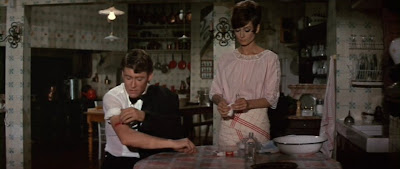Today was Peter O’Toole‘s 76th birthday, so in honour of the occasion I finally got around to watching a copy of How to Steal a Million (1966) that I took out of the library ages ago but hadn’t gotten around to seeing yet. And as I watched, I noticed an interesting parallel between this and one of O’Toole’s earlier films.
In How to Steal a Million, Audrey Hepburn accidentally shoots O’Toole in the arm after he sneaks into her home, and in the following scene, she prepares some iodine for his wound:
Compare this to the scene in Lawrence of Arabia (1962) where O’Toole is also shot in the arm, this time by a Turkish soldier who presumably wanted to hit him in a much more lethal place:
Are there any other examples of this in his filmography, I wonder?
As for How to Steal a Million as a whole, it’s a light, frothy confection — part heist film, part romantic comedy — of the sort that Old Hollywood was still churning out while New Hollywood was getting ready to take over the industry. There’s a scene in the film where Hepburn is reading an Alfred Hitchcock magazine, and in some ways this film feels like the sort of thing Hitchcock would have made in the 1950s — though by this point, he had moved on to grittier stuff like Psycho (1960) and The Birds (1963).
The two main reasons I was curious to see this film are O’Toole, of course, and the director, William Wyler.
O’Toole spends most of the film in quiet, witty banter mode, and he never quite gets the chance to explode the way that he did in other films of this period, such as Becket (1964) and The Lion in Winter (1968) — so there is something oddly restrained about his performance here. You can almost sense him dialing things back so as to fit within the genre. And just to show how conscious this film is of its debt to earlier movies, O’Toole even mimics an American gangster-style voice at a couple of points, to tease the Hepburn character about her interest in the heist.
Wyler, for his part, had been directing films since the silent era, winning three Oscars along the way, but he was on the verge of retirement here, and it shows. Not only was he working in a familiar genre, he was working with familiar actors, at least two of whom had earned Oscars under his direction; he had previously worked with Hepburn in Roman Holiday (1953) and The Children’s Hour (1961), and he had worked with Hugh Griffith, who plays Hepburn’s art-forging father, in Ben-Hur (1959).
Nothing here is up to the calibre of those films, alas, but you can’t really blame these people for wanting to spend time together on a movie set at least one more time before bidding farewell to the business. (Hepburn, too, pretty much retired a year or two after this; she was called out of retirement a few times over the next few decades, but this movie came near the end of an otherwise unbroken string of films going back to the early 1950s.)
How interesting, though, that they should share this last fling with an actor like O’Toole, who was just getting started back then.














